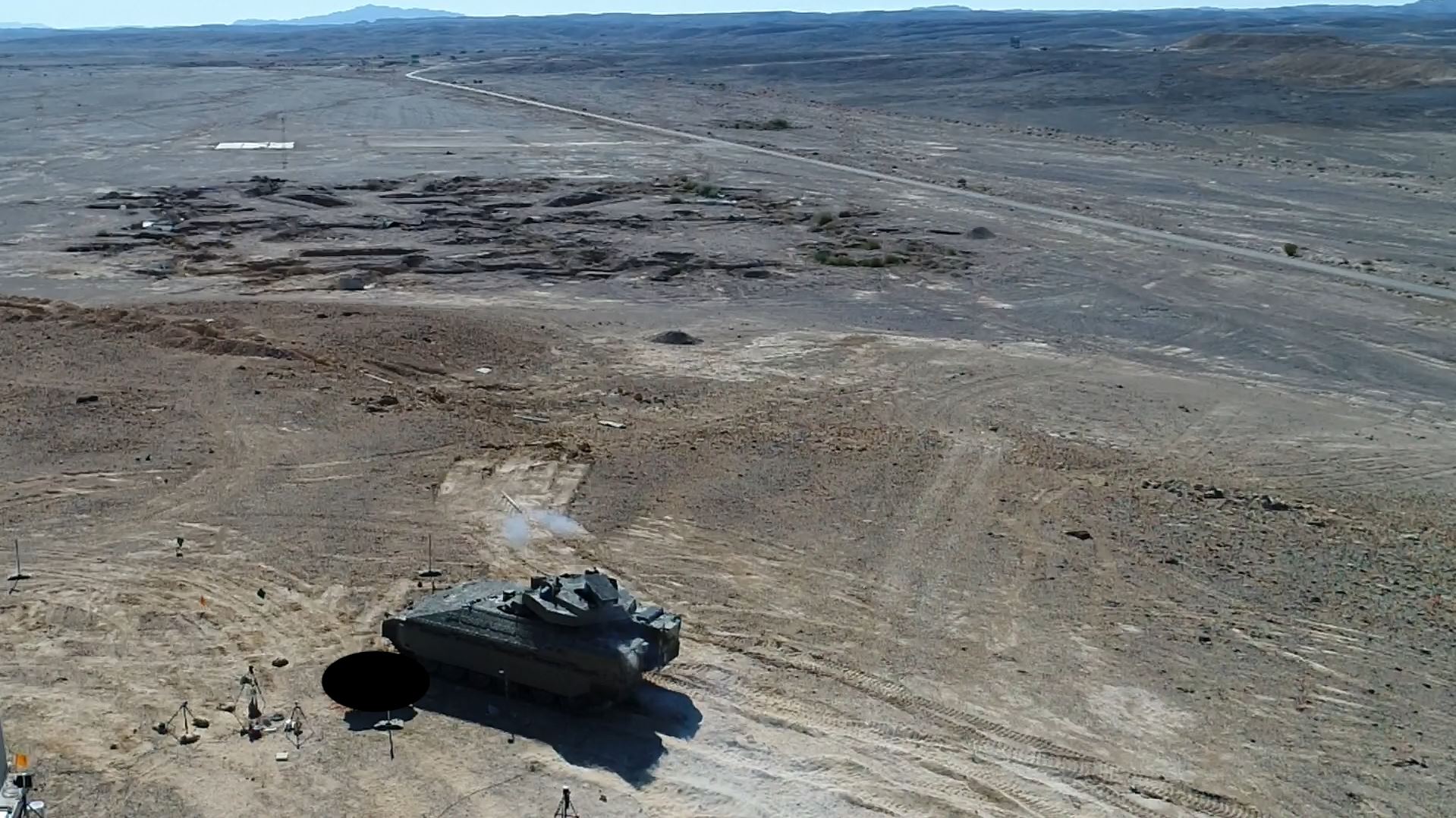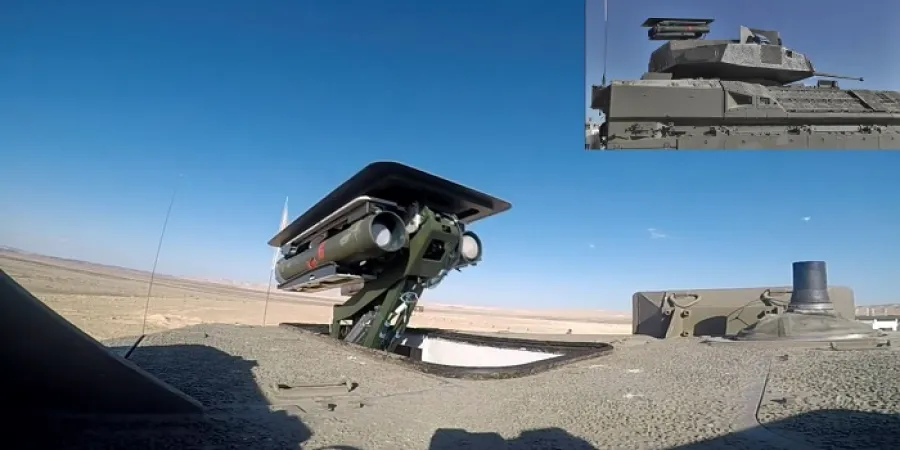In First, Spike Missile Launched from RCWS of Future Eitan APC
In the trials, Rafael’s Spike anti-tank guided missiles were successfully launched at simulated targets from a remote weapon station designed for IMOD’s Eitan and Namer armored personnel carriers
IsraelDefense
| 12/12/2018
The Merkava Tank & Armored Vehicle Administration (MANTAK) at IMOD has completed the first stage in a series of trials of the Remotely Controlled Weapon Station (RCWS) for the Eitan and Namer APCs. In the trials, Spike ATGMs by Rafael Advanced Defense Systems were launched successfully at simulated targets. The trial, conducted at the Shdema trial grounds, intended to test all of the operational functions of the RCWS.
MANTAK developed the RCWS to provide such capabilities as a 30mm cannon, state-of-the-art weapon sights, and other capabilities. The operators control the RCWS from within the crew compartment, to meet the challenges of the modern battlefield while providing the warfighters with maximum protection.
The RCWS consists of state-of-the-art, dedicated control systems enabling operation from within the crew compartment, to avoid exposing the warfighters to external threats. The new APCs will be fitted with an active protection system and other, specialized protective systems. The RCWS offers "over the hill" surveillance and fire capabilities.
The Eitan APC is the world's most advanced and protected wheeled fighting vehicle. The RCWS will enhance and upgrade the operational effectiveness of the new APC in open terrain as well as in built-up environments.
The trial constitutes the last stage in the process of integrating the Spike ATGM in MANTAK's RCWS. Spike ATGMs currently serve as a primary anti-tank weapon system in 30 militaries worldwide, with more than 30,000 missiles delivered to date. Spike is an electro-optically guided missile offering a "Fire-and-Forget" and "Fire-and-Observe" capabilities. The process of integrating the Spike ATGM in MANTAK's RCWS, completed successfully by a joint team of specialists from MANTAK and Rafael Advanced Defense Systems, will enable IDF warfighters to launch the missiles from within the armored vehicle, while remaining protected. This would significantly extend the striking range of the APCs.

According to recent reports, the IDF has acquired fifth-generation Spike-2 missiles. The Spike ATGM launcher mounted on the Namer and Eitan APCs can launch the new missiles, which would further extend the firing ranges of the APCs. Additionally, Spike LR2 missiles enable the engagement of targets without visual contact (line of sight) with the target, so the APCs would be able to launch the missiles from a reverse slope position without exposing themselves to the enemy.
“We constantly endeavor to find cutting-edge solutions adapted to the future battlefield, in addition to the objective of protecting the lives of the warfighters in the tank,” said Uriel Hochman, Head of Weapon Systems Section, Turret Branch at MANTAK. “The capabilities of the Remotely Controlled Weapon Station will significantly improve the performance of the forces operating on the ground, providing enhanced battlefield effectiveness.”
Zvi M., Head of the Precision Tactical Munitions Administration at Rafael Advanced Defense Systems, noted that the integration of the Spike missiles in the Remotely Controlled Weapon Stations of the Eitan and Namer APCs provides these vehicles with a significant operational advantage on the battlefield. This advantage stems from the ability to engage distant targets accurately in the context of numerous combat scenarios in the different theaters of operation.
In the trials, Rafael’s Spike anti-tank guided missiles were successfully launched at simulated targets from a remote weapon station designed for IMOD’s Eitan and Namer armored personnel carriers
The Merkava Tank & Armored Vehicle Administration (MANTAK) at IMOD has completed the first stage in a series of trials of the Remotely Controlled Weapon Station (RCWS) for the Eitan and Namer APCs. In the trials, Spike ATGMs by Rafael Advanced Defense Systems were launched successfully at simulated targets. The trial, conducted at the Shdema trial grounds, intended to test all of the operational functions of the RCWS.
MANTAK developed the RCWS to provide such capabilities as a 30mm cannon, state-of-the-art weapon sights, and other capabilities. The operators control the RCWS from within the crew compartment, to meet the challenges of the modern battlefield while providing the warfighters with maximum protection.
The RCWS consists of state-of-the-art, dedicated control systems enabling operation from within the crew compartment, to avoid exposing the warfighters to external threats. The new APCs will be fitted with an active protection system and other, specialized protective systems. The RCWS offers "over the hill" surveillance and fire capabilities.
The Eitan APC is the world's most advanced and protected wheeled fighting vehicle. The RCWS will enhance and upgrade the operational effectiveness of the new APC in open terrain as well as in built-up environments.
The trial constitutes the last stage in the process of integrating the Spike ATGM in MANTAK's RCWS. Spike ATGMs currently serve as a primary anti-tank weapon system in 30 militaries worldwide, with more than 30,000 missiles delivered to date. Spike is an electro-optically guided missile offering a "Fire-and-Forget" and "Fire-and-Observe" capabilities. The process of integrating the Spike ATGM in MANTAK's RCWS, completed successfully by a joint team of specialists from MANTAK and Rafael Advanced Defense Systems, will enable IDF warfighters to launch the missiles from within the armored vehicle, while remaining protected. This would significantly extend the striking range of the APCs.
According to recent reports, the IDF has acquired fifth-generation Spike-2 missiles. The Spike ATGM launcher mounted on the Namer and Eitan APCs can launch the new missiles, which would further extend the firing ranges of the APCs. Additionally, Spike LR2 missiles enable the engagement of targets without visual contact (line of sight) with the target, so the APCs would be able to launch the missiles from a reverse slope position without exposing themselves to the enemy.
“We constantly endeavor to find cutting-edge solutions adapted to the future battlefield, in addition to the objective of protecting the lives of the warfighters in the tank,” said Uriel Hochman, Head of Weapon Systems Section, Turret Branch at MANTAK. “The capabilities of the Remotely Controlled Weapon Station will significantly improve the performance of the forces operating on the ground, providing enhanced battlefield effectiveness.”
Zvi M., Head of the Precision Tactical Munitions Administration at Rafael Advanced Defense Systems, noted that the integration of the Spike missiles in the Remotely Controlled Weapon Stations of the Eitan and Namer APCs provides these vehicles with a significant operational advantage on the battlefield. This advantage stems from the ability to engage distant targets accurately in the context of numerous combat scenarios in the different theaters of operation.



